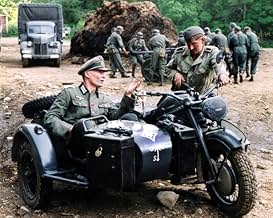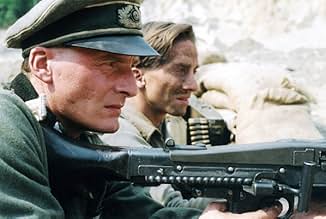Aggiungi una trama nella tua linguaSet in Northern Italy during the last embers of the war, the beleaguered vanguard of Axis forces suffer daily bombings and the constant threat of attack from local partisans. Tempers begin t... Leggi tuttoSet in Northern Italy during the last embers of the war, the beleaguered vanguard of Axis forces suffer daily bombings and the constant threat of attack from local partisans. Tempers begin to flare between these 'allies' as they await their impending doom.Set in Northern Italy during the last embers of the war, the beleaguered vanguard of Axis forces suffer daily bombings and the constant threat of attack from local partisans. Tempers begin to flare between these 'allies' as they await their impending doom.
- Regia
- Sceneggiatura
- Star
Recensioni in evidenza
In "Last Letters from Monte Rosa", we see the internal conflicts, as well as the external and how human beings relate and interact with one another, in a forced situation. We are shown that we can't escape ourselves. The heart will still have a place even in a time of war. And how different people can form unique bonds of understanding with one another and face their own individual challenges under difficult circumstances.
I really think that showing the heart of what it means to be human is Ari's strength. I hope Ari continues to make films showing the just how 'human' our lives are.
This is not a simple case of a director recycling material for convenience or marketability. What we are seeing here is closer in spirit to a final cut, a form of cinematic palimpsest in which the filmmaker revisits his previous work not just to streamline it, but to reframe its narrative structure and meaning. The most significant addition - and the one that redefines the entire rhythm and logic of the film - is the device of the letters. The insertion of these epistolary voiceovers functions not only as an organizing thread, but as a moral and emotional framing device that brings cohesion to what in The Fallen often felt like an ensemble mosaic of war vignettes drifting in and out of thematic focus.
In The Fallen, the fragmentary structure - while occasionally evocative - often left the viewer without a strong narrative spine. Scenes followed one another with a certain poetic inertia, emphasizing atmosphere over causality. The film was populated by morally conflicted characters, yet they remained suspended in a narrative fog, their arcs diluted by the film's own aesthetic ambitions. In this re-edited version, by contrast, the inclusion of the letters - ostensibly written by one of the soldiers - grounds the experience in a singular, retrospective point of view. It introduces a meditative melancholy and a personal temporality: these are not just scenes unfolding in real time, they are being remembered, mourned, processed. The war becomes a memory already in decomposition, and this grants the film a quiet gravity that the original version only hinted at.
This transformation is not without its paradoxes. For viewers familiar with The Fallen, watching Last Letters from Monte Rosa can be a disorienting experience. The visual déjà vu is constant, the compositions identical, the blocking familiar. But the effect is not merely repetitive. By repositioning and reframing the same footage within a more introspective narrative context, the film tests the idea that editing - and narration - can fundamentally alter meaning. A scene that once felt like one piece among many now reads as a part of a coherent whole. The removal of certain sequences, the reordering of others, and the slow burn of the voiceover reshape the material toward a more focused, almost elegiac form. In that sense, the film is both a reflection and a critique of its own predecessor.
One cannot ignore, however, the limitations inherent to such an approach. Despite the new structure, the film cannot escape the visual and tonal DNA of the earlier version. The acting, blocking, and mise-en-scène remain fixed in time; the letter device overlays meaning, but cannot always generate it. In moments, it risks feeling like a retrofit, an imposed structure rather than an organic one. Some sequences still retain the diffuse pacing and lack of dramatic propulsion that plagued The Fallen, and no amount of editorial refinement can fully compensate for that. Moreover, for viewers unfamiliar with the earlier film, certain redundancies in characterization or scene dynamics may feel repetitive, even without knowing why.
That said, the project's ambition deserves recognition. In an era where most re-edits are commercial or superficial (a few additional scenes, a marketing hook), this film represents a sincere artistic reconsideration. It asks: what happens when we remember differently? What if we tell the same story, but with a different center of gravity? The result is a film that, while still imperfect, acquires a somber dignity and narrative unity that was lacking in its former incarnation. Its melancholy is not only that of war, but also of cinema itself - the longing for a second chance, the hope that reshaping form can restore meaning.
Since this film is essentially a reassembly of The Fallen (2004), recontextualized through editorial and narrative changes, it's relevant to include here my review of that earlier version.
Shot in 2004, The Fallen emerges at a peculiar juncture in the history of war cinema-an era defined by a shift from grandiose depictions of heroism towards a more fractured, morally ambiguous portrayal of warfare. Post-Saving Private Ryan (1998), the early 2000s saw a proliferation of WWII films that attempted to emulate its visceral intensity while also distancing themselves from the mythologizing tendencies of earlier decades. This film, however, diverges notably from that trend, opting instead for a stripped-down, micro-historical focus that attempts to unravel the confusion, banality, and disorientation of ground-level combat and occupation politics on the Italian front. Its approach is atypical for American war cinema of the time, more aligned with the introspective tonalities of certain Italian war dramas than with Hollywood's penchant for catharsis.
Cinematographically, the film exhibits a rugged, almost documentary-like aesthetic. The camera tends to linger in wide shots, letting action unfold with minimal editorial intervention, which lends a certain observational realism. The lighting is consistently naturalistic, almost oppressively so, favoring overcast skies and dim interiors that render the color palette subdued and earthy. This visual austerity enhances the thematic focus on exhaustion and moral attrition among the characters. Yet, at times, this pursuit of realism risks lapsing into flatness-there are scenes where the visual language lacks rhythm, and the pacing becomes more soporific than meditative. Still, the overall effect is in keeping with the film's refusal to aestheticize combat.
One of the film's most effective aspects is its multilingual dialogue and the way it commits to linguistic authenticity. English, German, and Italian are spoken as they would be in the diegetic reality of 1944 Italy, and the film refuses to pander by subtitling or translating in ways that would comfort the viewer. This choice, while admirable, also distances the audience from immediate emotional engagement. In this sense, it shares an ideological kinship with The Grey Zone (2001), though that film belongs to a different subgenre (Holocaust/industrial extermination) and pushes further into existential horror. In The Fallen, this multilingual strategy reinforces the absurdity of war-miscommunications, cultural dissonances, and fragmented alliances dominate the psychological landscape.
The sound design is notably understated. Gunfire lacks the cinematic bravado typically heard in American productions; explosions feel more like dull concussions than choreographed peaks. The score, used sparingly, seems less interested in guiding emotion than in staying out of the way, contributing to the film's quasi-anthropological tone. In a way, the sonic design aligns more closely with A Midnight Clear (1992) than with more muscular counterparts like Enemy at the Gates (2001). Both films explore similar themes of misunderstanding and human connection across enemy lines, though The Fallen is more opaque, resisting the narrative symmetry or redemptive arcs that A Midnight Clear ultimately allows itself.
The acting ensemble delivers a grounded, unshowy set of performances, each actor embodying a national and ideological role that is slowly deconstructed as the story progresses. There is a deliberate avoidance of conventional "leads"-an ensemble approach that reflects the film's thematic interest in shared delusion and mutual disintegration. Characters are introduced with a kind of deliberate anonymity, a choice that serves the film's aim but sometimes hinders emotional investment. The performances from the Italian partisans, in particular, are finely calibrated, and avoid both romanticization and caricature. By contrast, the German soldiers are portrayed with a stiff precision that borders on stereotype at times, but this too may reflect the film's structural logic: order dissolving into disorder, certainty into confusion.
Crucially, The Fallen was produced at a time when the United States was deep into the Iraq War, and this context inevitably bleeds into the film's moral framing. Its thematic refusal to endorse a clean dichotomy between good and evil, its emphasis on the futility of command hierarchies in the fog of battle, and its depiction of soldiers from different factions sharing moments of disoriented solidarity, all suggest a subtextual engagement with contemporary skepticism toward military interventionism and the narratives that justify it. The film isn't propagandistic or even didactic-it operates in a space of disillusionment, much closer in spirit to Cross of Iron (1977), though it lacks that film's operatic nihilism. Rather, it is a quiet, almost academic autopsy of a historical moment in which ideology falters and only the mechanics of survival remain.
Nonetheless, this is a film that understands the structural anatomy of war at a granular level. Its micro-historical approach-focusing on a relatively minor skirmish, a sliver of the front, and a disparate group of disoriented soldiers-delivers a portrait not of WWII as a clash of ideologies, but as a slow, unraveling catastrophe of miscommunication, missed opportunities, and unintended consequences.
Lo sapevi?
- QuizThis film was seven years in the making.
- ConnessioniEdited from The Fallen (2004)
I più visti
Dettagli
Botteghino
- Budget
- 300.000 USD (previsto)
- Tempo di esecuzione1 ora 28 minuti
- Colore
- Proporzioni
- 1.85 : 1




















